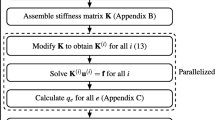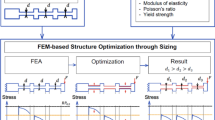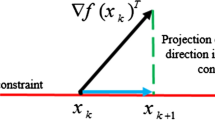Abstract
A Sequential Element Rejection and Admission (SERA) method to design compliant mechanisms with topology optimization techniques is presented in this work. This procedure allows material to flow between two different material models: ‘real’ and ‘virtual’. The method works with two separate criteria for the rejection and admission of elements to efficiently achieve the optimum design. The SERA method overcomes the problems encountered by the ESO method when used to design compliant mechanisms. Three benchmark problems are presented to show the validity and robustness of the SERA method to design complaint mechanisms, regardless of the design parameters chosen.

















Similar content being viewed by others
References
Ananthasuresh GK, Kota S, Gianchandani Y (1993) Systematic synthesis of micro compliant mechanisms: preliminary results. In: Proc. 3rd national conf of appl mech and robot, Ohio, 2(82)
Ananthasuresh GK, Kota S, Gianchandani Y (1994) A methodical approach to the design of compliant micromechanisms. In: Solid state sensor and actuator workshop, pp 189–192
Ansola R, Vegueria E, Canales J, Tárrago J (2007) A simple evolutionary topology optimization procedure for compliant mechanism design. Finite Elem Anal Des 44:53–62
Bendsoe MP (1989) Optimal shape design as a material distribution problem. Struct Optim 1:193–202
Bendsoe MP, Sigmund O (2003) Topology optimization: theory, method and application. Springer, Berlin
Bums R, Crossley F (1968) Kinetostatic synthesis of flexible mechanisms. ASME ASME-Paper No. 68-Mech-36
Her I, Midha A (1987) A compliance number concept for compliant mechanisms, and type synthesis. ASME J Mech, Transm, Autom Des 109(3):348–355
Howell L (2001) Compliant mechanisms. Wiley, New York
Howell L, Midha A (1994a) A generalized loop-closure theory for the analysis and syrithesis of compliant mechanisms. ASME Mach Elem Mach Dyn 116:491–500
Howell L, Midha A (1994b) A method for design of compliant mechanisms with small length flexural pivots. ASME Mach Elem Mach Dyn 116:280–290
Luo Z, Tong L (2008) A level set method for shape and topology optimization of large-displacement compliant mechanisms. Int J Numer Methods Eng 76:862–892
Parsons R, Canfield S (2002) Developing genetic programming techniques for the design of compliant mechanisms. Struct Multidisc Optim 24:78–86
Pedersen C, Buhl T, Sigmund O (2001) Topology synthesis of large-displacement compliant mechanisms. Int J Numer Methods Eng 50:2683–2705
Petersen K (1982) Silicon as a mechanical material. Proc IEEE 70(5):420–457
Querin OM, Steven G, Xie Y (2000) Evolutionary structural optimization using an additive algorithm. Finite Elem Anal Des 34:291–308
Rozvany GIN, Querin OM (2001) Present limitations and possible improvements of SERA (Sequential Element Rejections and Admissions) methods in topology optimization. In: The 4th world congress of structural and multidisciplinary optimization (WCSMO-4), Dalian, China, 4–8 June 2001, extended abstracts, pp 48–49, CD-ROM paper 335
Rozvany GIN, Querin OM (2002a) Combining ESO with rigorous optimality criteria. Int J Veh Des 28(4):294–299
Rozvany GIN, Querin OM (2002b) Theoretical foundations of Sequential Element Rejections and Admissions (SERA) methods and their computational implementations in topology optimisation. In: 9th AIAA/ISSMO symposium on multidisciplinary analysis and optimization, 4–6 Sept 2002. doi:10.2514/6.2002-5521
Saxena A (2005) Topology design of large displacement compliant mechanisms with multiple materials and multiple output ports. Struct Multidisc Optim 30:477–490
Sevak N, Mclaman C (1974) Optimal synthesis of flexible link mechanisms with large static deflection. ASME Paper No. 74-Der-83
Sharma D, Deb K, Kishore N (2011) Domain-specific initial population strategy for compliant mechanisms using customized genetic algorithm. Struct Multidisc Optim 43:541–554
Shield R, Prager W (1970) Optimal structural design for given deflection. J Appl Math Phys 21:513–523
Sigmund O (1997) On the design of compliant mechanisms using topology optimization. Mech Struct Mach 25(4):493–524
Sigmund O (2001a) Design of multiphysics actuators using topology optimization. Part I: One-material structures. Comput Methods Appl Eng 190(49–50):6577–6604
Sigmund O (2001b) Design of multiphysics actuators using topology optimization. Part II: Two-material structures. Comput Methods Appl Eng 190
Sigmund O, Petersson J (1998) Numerical instabilities in topology optimization: a survey on procedures dealing with checkerboards, mesh-dependencies and local minima. Struct Optim 16:68–75
Yamada T, Yamasaki S, Nishiwaki S, Izui K, Yoshimura M (2011) Design of compliant thermal actuators using structural optimization based on the level set method. J Comput Inf Sci Eng 11(1):011005
Yulin M, Xiaoming W (2004) A level set method for structural topology optimization and its applications. Adv Eng Softw 35:415–441
Zhou M, Rozvany GIN (1991) The COC algorithm, Part II: topological, geometrical and generalized shape optimization. Comput Methods Appl Mech Eng 89:309–336
Acknowledgements
This work was partially supported by the Departamento de Educación of the Gobierno de Navarra with the PhD scholarship of Cristina Alonso Gordoa. Its support is greatly appreciated.
This work was also partially supported by the Ministry of Education and Science in Spain through the project DPI2012–36600.
Author information
Authors and Affiliations
Corresponding author
Appendix: Sensitivity analysis
Appendix: Sensitivity analysis
This section shows the derivation of the sensitivity analysis of the objective function with respect to the design variable.
The derivative of the MPE with respect to the element density is given in (21).
Since the stiffness matrix is symmetric, the first derivative is then given in (22).
Giving the derivative of the MPE to be (23).
The two equilibrium (4) and (5) are differentiated with respect to the density and are given in (24) and (25). The input load is independent from the design variables and its derivative is zero.
The equivalences obtained in (24) and (25) are introduced to (23), giving the derivative of the MPE to be (26).
As each density variable corresponds to a unique mesh element, only the displacements and stiffness of that element needs to be considered in the calculation. The sensitivity number for an element \(e\), \(\alpha _{e}\) can be calculated using (27).
where: U 1e is the displacement vector of element e due to load case 1; U 2e is the displacement vector of element \(e\) due to load case 2; and \(\frac {\partial \mathbf {K}_e} {\partial \rho _e} \) is the derivative of the elemental stiffness matrix with respect to the density.
The derivative of the stiffness matrix with respect to the density can only be approximated to the variation of the elemental stiffness (28). This is because the design variables are discrete (density can only be zero or the unit) and as a consequence, the elemental stiffness can only be the value of a ‘real’ material, K e or a negligible value equivalent to zero.
When the approximation to the variation of the elemental stiffness in (28) is substituted to the expression of the elemental sensitivity number (27) and the relative volume of the FE is factored, (6) is obtained.
Rights and permissions
About this article
Cite this article
Alonso, C., Querin, O.M. & Ansola, R. A Sequential Element Rejection and Admission (SERA) method for compliant mechanisms design. Struct Multidisc Optim 47, 795–807 (2013). https://doi.org/10.1007/s00158-012-0862-9
Received:
Revised:
Accepted:
Published:
Issue Date:
DOI: https://doi.org/10.1007/s00158-012-0862-9




